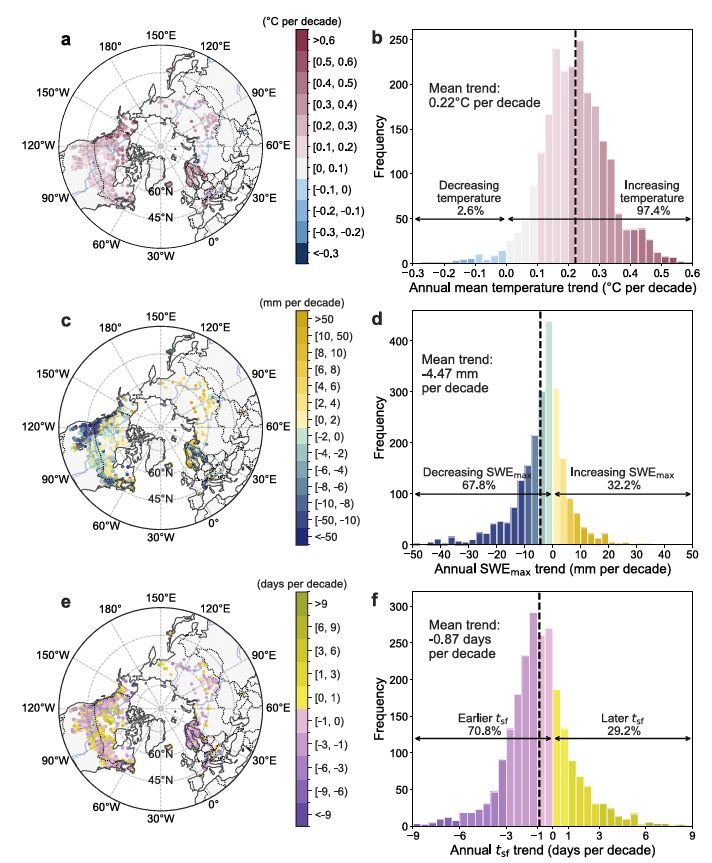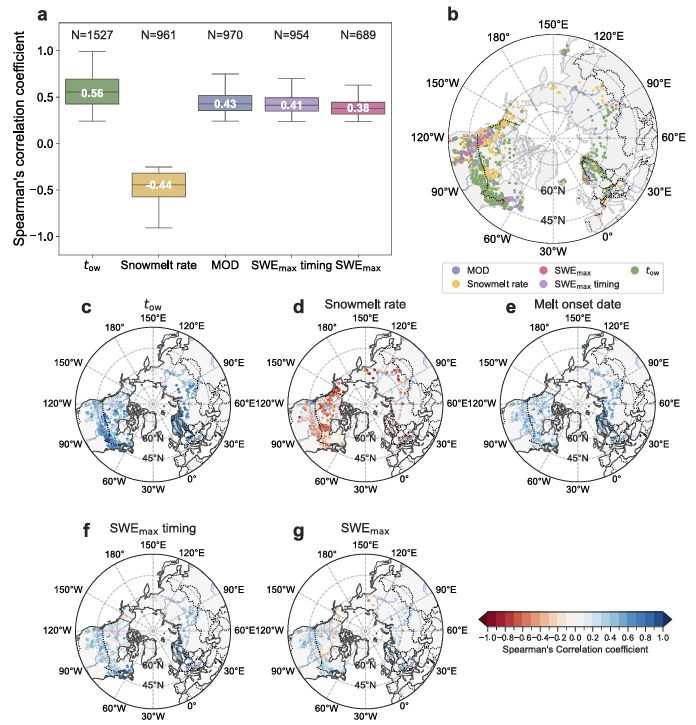On April 17, the research team led by Professors YANG Dawen and YANG Yuting from the Department of Hydraulic Engineering at Tsinghua University published their latest study in Nature Communications, titled “Warming Leads to Both Earlier and Later Snowmelt Floods Over the Past 70 Years.” The study reveals that, over the past seven decades, climate warming has caused complex shifts in the timing of snowmelt floods in cold regions of the Northern Hemisphere, with earlier occurrences in some river basins and significant delays in others. This finding challenges the conventional belief that climate warming universally leads to earlier snowmelt floods. It provides new scientific insights for flood forecasting, disaster prevention and mitigation, and water resource management in cold regions.
Based on observed runoff records and ERA5-Land reanalysis data from 2339 snow-affected catchments across the Northern Hemisphere between 1950 and 2020, the research team developed a flood event detection and classification tool (idfloodPy). From over 240000 flood events, they identified more than 100000 annual maximum snowmelt floods. For the first time, these events’ temporal evolution and key driving factors were systematically analyzed at the hemispheric scale. The main findings of the study are summarized as follows:
(1) Snowmelt floods do not occur uniformly earlier. Approximately 30% of the catchments show a significant trend toward later occurrences. Although, on average, snowmelt floods in the Northern Hemisphere have shifted about 0.87 days earlier per decade, substantial regional differences exist, with some catchments experiencing delays of more than 6 days per decade. This bidirectional shift, with both earlier and later snowmelt floods, is primarily driven by two opposing mechanisms. On one hand, climate warming causes the onset of seasonal warming (tow) to occur earlier each year, promoting earlier snowmelt and thus advancing the timing of snowmelt floods. On the other hand, warming also causes snowmelt to begin earlier in the season, when internal heat within the snowpack is still insufficient. This slows the melting rate, reducing the accumulation of meltwater or prolonging the time required for meltwater to converge in the river system, ultimately delaying the occurrence of snowmelt floods.
(2) The dominant factors influencing snowmelt flood timing vary regionally. Among these, the onset of seasonal warming (tow) is the primary driver of timing shifts, serving as the leading factor in approximately half of the catchments, mainly located in the mid-latitudes of North America, Central Europe, and Central Siberia. The second most influential factor is the snowmelt rate, which plays a dominant role in high-altitude cold regions such as the Rocky Mountains and the Alps. In contrast, traditionally emphasized factors, such as the timing of maximum annual snow water equivalent (SWEmax) or the melt onset date, have a comparatively weaker influence on the timing of snowmelt floods.
The study also finds that catchments experiencing earlier snowmelt floods are primarily influenced by a combination of earlier warming onset, reduced snow accumulation, and accelerated snowmelt rates. In catchments where snowmelt floods are delayed, the slowing of the snowmelt rate outweighs the effect of earlier warming, making it the dominant factor controlling flood timing. This differentiated response reveals that the evolution of snowmelt floods is far more complex than previously expected, highlighting the need for dynamic monitoring and management in the face of changing climate conditions. The previously simplified model, “warming → earlier snowmelt → earlier floods,” urgently needs to be revised to fully account for the impact of changes in snowmelt rates. The study also recommends incorporating variables such as the onset of seasonal warming and snowmelt rate into future flood early warning systems to improve the accuracy and regional relevance of snowmelt flood forecasting.
The first author of this paper is Dr. GUO Yuhan, a postdoctoral researcher in the Department of Hydraulic Engineering at Tsinghua University. Professors YANG Dawen and YANG Yuting, also from the same department, are the co-corresponding authors. The co-authors include Professor ZHANG Lu from Wuhan University, Dr. ZHENG Hongxing from CSIRO Australia, Dr. LIU Ziwei from the National University of Singapore, and PhD candidates XIONG Jinghua, RUAN Fangzheng, and HAN Juntai from Tsinghua University. This research was supported by the National Key R&D Program of the Ministry of Science and Technology and a major special project funded by the Qinghai Provincial Department of Science and Technology.

Fig. 1| Trends in temperature, maximum snow water equivalent, and snowmelt flood timing across 2339 catchments over 1950–202

Fig. 3 | Factors affecting snowmelt flood timing
Read the original article at: https://www.nature.com/articles/s41467-025-58832-0